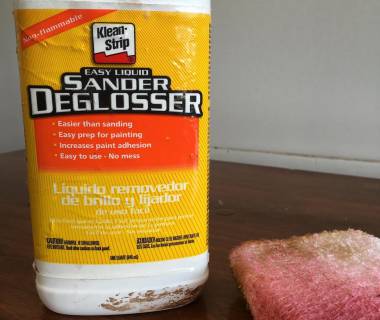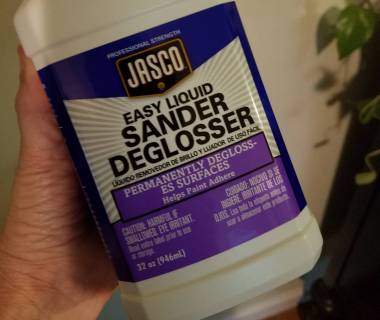Liquid sandpaper, also known as deglosser or wet sanding, is a very useful product. If you have no idea what liquid sandpaper is, it’s a solution that’s designed to be an alternative to traditional sandpaper.
This chemical solution contains ethyl acetate, ethyl alcohol, and naphtha. Stronger liquid sandpaper solutions also consist of the chemical tri-sodium phosphate (TSP). These stronger solutions tend to work more efficiently than the weaker ones.
The difference between liquid sandpaper and traditional sandpaper
Liquid sandpaper is used to sand items just as you would with traditional sandpaper. However, it’s mainly used to remove the glossy layer off an already painted item, so you can paint over it without the new paint dripping off and causing a mess.
It can also be used to remove the first layer of paint from a particular surface. Once removed, the surface is rough and can be painted over. Lastly, Liquid sandpaper is quite effective in removing excess waxy layers and protective coats from surfaces and objects like lawn furniture.
So, what can’t Liquid sandpaper do? This chemical solution is not effective in fixing imperfections, it can’t smooth surfaces, and it can’t be used as a paint primer. Now that you know a little bit about liquid sandpaper, why should you choose this sandpaper over traditional kinds?
The advantages of using liquid sandpaper
First, liquid sandpaper is much easier to use. Traditional sandpaper requires repetitive movement which can cause physical exertion and other physical issues like sore muscles, aches and pains, and even fatigue. Eliminate the hassle with liquid sandpaper.
Second, sanding a surface with traditional sandpaper will produce a lot of dust floating dust particles. If these particles are inhaled, they can cause health issues like dizziness, nausea, and respiratory problems, especially for individuals with asthma.
This is especially true with older homes that have painted surfaces consisting of lead. The dust particles created by this kind of paint can be extremely dangerous to your health. Make sure you always wear a mask when you find yourself in this situation.
Third, not only does traditional sandpaper produce lots of dust particles in the air, you’ll also have quite a mess to clean up too. The dust produced by sanding with traditional sandpaper will need to be swept up from the floor ,and anywhere else it went flying.
It will get on your clothes, in your hair, and it can even get in your home’s carpet and on the drapes. Cleaning up this dust is both time consuming and a hassle. Save yourself the effort and the time by using liquid sandpaper instead. You’ll be glad you did.
Fourth, liquid sandpaper can easily remove the paint from objects with a lot of intricate details ,including curves, grooves, holes, and special carvings. Traditional sandpaper just doesn’t work as well with these objects. Liquid sandpaper can get into the little areas that traditional sandpaper can’t.
Fifth, liquid sandpaper works really fast, much faster than using traditional sandpaper. In fact, liquid sandpaper works in about 15 minutes. That’s it. By saving this much time, you can dedicate more of your attention to other projects.
Lastly, liquid sandpaper works wonders for preparing a variety of surfaces for further necessary repairs and refinishing jobs. Liquid sandpaper is definitely a very versatile product that’ll make your life much easier.
How to use liquid sandpaper

If you’ve decided to use liquid sandpaper for your home improvement project, it’s important that you fully understand how to use liquid sandpaper properly before you start. Follow these easy steps:
- The first thing you’ll want to do before you use liquid sandpaper is to wash the surface you’ll be using the chemical solution on. Use a soft soap like dish soap or hand soap. The idea here is to remove all the dirt, dust, and filth completely.
- The next thing you’ll want to do is dry off the surface with a clean rag or towel. This surface needs to be completely dry before you begin. To be safe, it’s best to also give the surface about 15 minutes to air dry. Liquid sandpaper won’t properly stick if it’s applied to a damp surface. The slightest bit of moisture could cause problems for you.
- Equip yourself with a lint-free cloth and apply the liquid sandpaper to the surface. A lint-free cloth is important to the overall quality of the job. When you’re applying the liquid sandpaper, use slow, easy strokes. This will help you from sloping it everywhere.
- After you’ve applied the liquid sandpaper to the areas you want sanded, let it sit for the recommended time. To find this information, read the instructions on the side of the container or bottle.
- Take another clean, lint-free cloth and dry off the surface you just liquid sanded. Make sure you get it good. Again, read the instructions on the side of the container or bottle. Different brands tend to have slightly different removal methods.
- Inspect the surface to see if it’s ready to be painted. If not, repeat the process listed above until it is.
That is how you properly apply liquid sandpaper to a surface. If you do it right, your surface will be easier to paint, and it will look better in the end.
Is it possible to use liquid sandpaper on particle board?
Before tackling this question, it’s best to have a good understanding of what particle board actually is. Particle board is a less expensive, alternative version of hardwood. It’s environmentally friendly, and it’s made out sawdust, wood shavings, and resin.
If you didn’t already know, moisture will destroy particle board. Moisture will weaken and stain the board. Because liquid sandpaper is a wet chemical solution, it should not be used. Instead, it’s best to use traditional sandpaper on particle board. The only time it’s possible to use liquid sandpaper on particle board is when the board has a layer of wood with a smooth polished surface.
Choosing the right liquid sandpaper for your project

There are several different kinds of liquid sandpaper products on the market. How do you know which one is a good choice? The first thing you can do is to read the reviews. These reviews are submitted by real customers who have used the product before. By learning from other people’s mistakes, you’ll won’t make the same ones yourself.
Second, choose a liquid sandpaper product that’s appropriate for the job you’re doing. For instance, some liquid sandpaper products are better suited for wood surfaces whereas others are made for metal. As mentioned earlier, the strength of the liquid sandpaper will be dependent on the kind you choose. Some solutions are milder, whereas others are extremely strong.
Lastly, it’s best to go with a name brand. Although the idea of saving money sounds good, names brands tend to perform a lot better than bargain buys. By choosing a higher quality liquid sandpaper, your surfaces will look that much better. Some of the top products in this market include:
☆ Klean-Strip Easy Liquid Sandpaper
☆ Neo Tac Liquid Sandpaper
☆ Brunswick Liquid Sandpaper
These are just a few of the top brands sold in stores these days. Most home improvement stores will carry them, and they’re available for a very affordable price.
A few tips when using liquid sandpaper
When using liquid sandpaper, you’ll want to make use of these easy tips for not only your safety but for others around you. First, always read the instructions on the bottle.
This includes the warning message and the ‘how to use’ tips. Not every brand puts these tips on the side of their bottle, but if you see it listed, take the time to read it.
Always use liquid sandpaper in a well-ventilated area and away from children. The fumes from the liquid sandpaper are harmful to breathe in and can result in health issues, especially for individuals with asthma. Inhaling the fumes from liquid sandpaper can also cause dizziness, nausea, and if exposed to often, brain damage.
Many professionals suggest using a high-quality face mask when applying this chemical solution. Face masks aren’t too pricey and can be purchased at most home improvement stores.
Another tip you’ll want to remember is always to wear gloves and eye protection when applying liquid sandpaper. Some face masks do cover the eyes, but if yours doesn’t, you’ll need to get some eye protection. Liquid sandpaper can burn the skin and cause eye damage if accidents occur, so always use extreme precaution when applying this chemical solution.
Lastly, make sure you always dispose of your excess liquid sandpaper properly. Poring it down the drain or flushing it down the toilet is a bad decision. It can get into the waterways and contribute to the pollution in the environment. Instead, dispose of the solution at your local hazardous waste site.
- Painting Over Powder Coat and What You Need to Know - February 1, 2022
- How to Get Rid of Humidity in a Basement Without a Dehumidifier - December 17, 2021
- How to Fix a Crack in Drywall That Keeps Coming Back - September 22, 2021

Raegan
Saturday 4th of March 2023
Have you ever used liquid sandpaper on cane? I have some dining chairs with cane backs that were stained and have 2 coats of oil-based poly. I’d like to prime/paint the cane. Would liquid sandpaper work well on the cane? I don’t think traditional sanding would be effective and might damage it, so looking for alternatives to prep the cane surface.